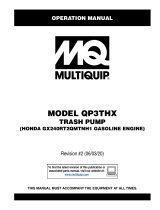
Before operating or installing
this pump, read this manual and
follow all safety warnings and
operating instructions.
SAFETY WARNINGS
warning: Carefully read the safety messages in this manual and on the
pump. Keep this manual with the pump at all times.
attention: rental companies and private owners
who rent or lend this pump to others:
All persons to whom you rent or lend this pump must have access to and read
this owner's manual. Keep this manual with the pump at all times and advise all
persons who will operate the pump to read it. You must also provide personal
instruction on how to safely operate the pump, and you must be available to
answer any questions that the renter or borrower might have.
warning: when starting the pump:
Rapid retraction (kickback) of the starter cord can pull your hand and arm toward
the engine faster than you can let go. Broken bones, fractures, bruises, or sprains
could result. To avoid kickback, pull the starter cord slowly until resistance is felt,
then pull rapidly to start the engine.
Keep your hands and body clear from the discharge of the pump.
Make sure all connections are tight.
Secure the pump. Loads from the hoses may cause tipover.
Secure the discharge hose to avoid whipping.
Unintentional sparking can result in fire or electric shock. DO NOT crank the
engine with the spark plug removed. Ensure that the spark plug, muffler, fuel cap,
and air cleaner are in place.
If fuel spills, wait until it evaporates before starting engine.
warning: when operating the pump:
When running, the engine on this pump produces carbon monoxide, an odorless,
colorless, poison gas. Breathing carbon monoxide can cause nausea, fainting,
or death. Operate this pump ONLY outdoors. Do not operate the pump inside
any building, confined area, or enclosure such as basements, garages, or similar
locations, even if doors and windows are open.
The engine exhaust from this pump contains chemicals known to the State of
California to cause cancer, birth defects, and other reproductive harm.
Keep exhaust gas from entering a confined area through windows, doors,
ventilation intakes, or other openings.
The starter and other rotating parts can entangle hands, hair, clothing, or
accessories. NEVER place hands or body parts inside of running pump or hoses.
DO NOT wear loose clothing, jewelry, or anything that may be caught in the
starter or other rotating parts. Tie up long hair and remove jewelry.
Running engines produce heat. The temperature of the muffler and nearby areas
can reach or exceed 150°F (65°C). Severe burns can occur on contact.
Avoid hot exhaust gases and DO NOT touch hot surfaces.
The pump must be at least 5 feet from structures having combustible walls and/or
other combustible materials such as leaves, grass, and brush. These can catch
fire.
Reflective exhaust heat may damage the fuel tank, causing fire. Keep at least 3
feet of clearance on all sides of the pump for adequate cooling, maintenance,
and servicing.
DO NOT use to pump flammable liquids such as fuel or fuel oils.
DO NOT use to pump fluid intended for human consumption.
DO NOT use in mobile equipment or marine applications.
DO NOT tip the pump at an angle that causes fuel to spill.
Secure the pump. Loads from the hoses may cause tipover.
engine-driven
aluminum transfer pump
DO NOT stop the engine by moving the choke lever to the CHOKE position.
Wear ear protection to reduce objectionable noise.
Code of Federal Regulation (CFR) Title 36 Parks, Forests, and Public Property
require equipment powered by an internal combustion engine to have a spark
arrester, maintained in effective working order, complying to USDA Forest service
standard 5100-1C or later revision. In the State of California a spark arrester is
required under section 4442 of the California Public resources code. Other states
may have similar laws.
warning: when adJusting or maKing repairs to
the pump:
Turn the engine off.
Allow equipment to cool before touching.
Disconnect the spark plug wire from the spark plug and place the wire where it
cannot contact the plug.
warning: when testing for engine sparK:
Use an approved spark plug tester.
DO NOT check for spark with spark plug removed.
warning: when adding or draining fuel:
Turn the pump OFF and let it cool at least 2 minutes before removing the fuel
cap.
Loosen the cap slowly to relieve pressure in tank.
Fill or drain the fuel tank outdoors.
DO NOT overfill the fuel tank. Allow space for fuel expansion.
Keep fuel away from sparks, open flames, pilot lights, heat, and other ignition
sources.
DO NOT light a cigarette or smoke.
warning: when transporting or repairing the
pump:
Empty the fuel tank or close the fuel valve.
Disconnect the spark plug wire.
warning: when storing fuel (or pump with fuel
in tanK):
Store the pump away from furnaces, stoves, water heaters, clothes dryers, or
other appliances that have a pilot light or other ignition source because they can
ignite fuel vapors.
caution: DO NOT operate this pump dry!
Excessively high operating speeds increase risk of injury and damage to pump.
Excessively low speeds impose a heavy load.
DO NOT tamper with the governed speed.
DO NOT modify the pump in any way.
DO NOT allow unqualified persons or children to operate or service pump.
DO NOT insert any objects through cooling slots.
Treating the pump improperly can damage it and shorten its life.
Be sure pump chamber is filled with water before starting the engine. NEVER run
pump without priming.
Use a non-collapsible hose on the suction side of the pump.
Use the pump only for its intended uses.
SAFETY













